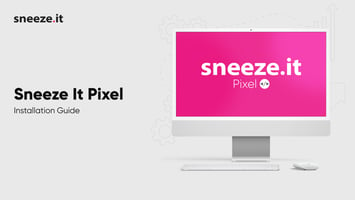In today's fast-paced digital landscape, businesses must adapt and evolve to stay ahead of the...
Developing Your Advertising Message and Creatives: A Comprehensive Guide
.jpg?width=1280&height=720&name=Blog%20post%20second%2030%20(1).jpg)
In this in-depth blog, we will guide you through the process of developing your advertising message and creatives, providing examples, context, best practices for each platform, and general overviews. Our goal is to equip you with the knowledge and tools needed to create compelling and persuasive advertising campaigns that resonate with your target audience and drive results.
Defining Your Advertising Message

Before diving into the creative aspects of your campaign, it's crucial to define your advertising message. Your message should be clear, concise, and targeted to your audience. Follow these steps to develop a compelling advertising message:
- Define Your Objectives: Determine the goal of your campaign. Are you looking to increase brand awareness, generate leads, or drive sales? Your objectives will guide your messaging and creative direction.
- Identify Your Target Audience: Understand your ideal customer and what motivates them. Consider demographics, psychographics, and behavioral attributes to create a detailed customer persona.
- Develop Your Unique Selling Proposition (USP): Identify the unique benefits of your product or service that sets you apart from competitors. Your USP should address the pain points and desires of your target audience.
- Craft Your Message: Develop a clear, concise, and persuasive message that highlights your USP and speaks directly to your target audience. Keep it simple, memorable, and action-oriented.
Crafting Your Creative Assets

Once you've defined your advertising message, it's time to create your creative assets. These include images, videos, and copy that will convey your message across various platforms. Here are some tips for crafting effective creative assets:
- Align With Your Brand: Ensure all creative assets are consistent with your brand's visual identity, tone, and voice.
- Be Platform-Specific: Tailor your creative assets for each platform, taking into account the unique requirements and best practices for each.
- Use High-Quality Visuals: Invest in high-quality images and videos that are eye-catching and professionally produced.
- Keep Copy Clear and Concise: Write copy that is easy to read, concise, and communicates your message effectively. Avoid jargon and complicated language.
- Include a Call to Action (CTA): Encourage your audience to take action with a clear and compelling CTA. Be specific and direct with your CTA, such as "Buy Now" or "Sign Up."
Best Practices for Each Platform

- Utilize the Right Ad Formats: Facebook and Instagram offer various ad formats, including single image, carousel, collection, and video ads. Choose the format that best showcases your product or service and aligns with your campaign objectives.
- Use High-Quality Visuals: Both platforms prioritize visual content, so invest in high-quality images and videos that stand out in users' feeds.
- Optimize Ad Copy: Keep your headlines concise (under 25 characters) and your ad text short (under 125 characters). Include a clear and persuasive CTA.
- Leverage Targeting Features: Utilize Facebook's extensive targeting options to reach your ideal audience based on demographics, interests, and behaviors.
- Test and Optimize: Run A/B tests with different creative assets and targeting options to find the most effective combinations. Continuously optimize your campaigns based on performance data.
- Choose the Right Ad Format: Google Ads offers several formats, including search, display, video, and shopping ads. Select the format that aligns with your campaign objectives and target audience.
- Focus on Keywords: Research and select relevant keywords that your target audience is likely to search for. Use these keywords strategically in your ad copy and headlines.
- Write Compelling Ad Copy: Create concise, persuasive ad copy that highlights your USP and includes a strong CTA. Ensure that your headlines and descriptions are relevant to your chosen keywords.
- Optimize for Quality Score: Google Ads uses a quality score to determine your ad's relevance and performance. Improve your quality score by optimizing your ad copy, landing pages, and keywords.
- Manage Bids and Budget Strategically: Consistently evaluate and modify your bids and daily budget based on your campaign's performance and objectives. Keep a close eye on metrics like cost-per-click (CPC) and cost-per-acquisition (CPA) to ensure that your campaigns remain cost-efficient and aligned with your goals.
- Select the Appropriate Ad Format: LinkedIn offers sponsored content, sponsored InMail, and display ads. Choose the format that aligns with your campaign goals and target audience.
- Optimize for Professional Audiences: Craft your messaging and creative assets with a professional tone that appeals to LinkedIn's user base.
- Leverage Targeting Options: Utilize LinkedIn's targeting capabilities, such as industry, job title, and company size, to reach your ideal audience.
- Test and Optimize: Continuously test and optimize your campaigns by experimenting with different creative assets, targeting options, and ad formats.
- Choose the Right Ad Format: Twitter offers promoted tweets, promoted accounts, and promoted trends. Select the ad format that aligns with your campaign objectives.
- Use Engaging Visuals: Incorporate eye-catching images, GIFs, or videos to stand out in users' feeds and increase engagement.
- Write Concise and Engaging Copy: Keep your ad copy short and impactful, using no more than 280 characters. Include relevant hashtags and a clear CTA.
- Utilize Targeting Features: Leverage Twitter's targeting options, such as keywords, interests, and demographics, to reach your target audience.
- Monitor and Optimize: Analyze your campaign performance regularly and make necessary adjustments to improve engagement and reach.
Other Obscure Platforms and Key Factors to Consider

While major platforms like Facebook, Google, LinkedIn, and Twitter dominate the digital advertising landscape, there are also niche or obscure platforms that might be relevant to your business. Some examples include Pinterest, Snapchat, TikTok, and Reddit. When exploring these platforms, consider the following key factors:
- Audience Demographics: Research the platform's user demographics to ensure that it aligns with your target audience. Consider factors like age, gender, location, interests, and income.
- Platform-Specific Content: Create content that is tailored to the unique characteristics and formats of each platform. For instance, TikTok is ideal for short, engaging videos, while Pinterest works best for visually striking images.
- Ad Format Options: Familiarize yourself with the ad formats available on each platform and select the one that best suits your campaign objectives and creative assets.
- Targeting Capabilities: Evaluate the targeting options provided by each platform and ensure they align with your target audience and campaign goals.
- Analytics and Reporting: Ensure that the platform offers robust analytics and reporting tools to monitor and optimize your campaigns effectively.
Developing a compelling advertising message and creative assets is essential to the success of your digital advertising campaigns. By understanding the unique requirements and best practices for each platform, crafting platform-specific content, and continuously testing and optimizing your campaigns, you can create persuasive advertising that resonates with your target audience and drives results. Armed with this knowledge, you're now better prepared to explore digital advertising options and make informed decisions when hiring a digital advertising agency.
Want to keep learning? Check our Comprehensive Guide to Digital Advertising.
Excited about crafting your own compelling advertising message and creatives after reading our guide? We're sure you're brimming with ideas and perhaps a few questions too. Don't hesitate, schedule a friendly chat with our team today and let's bring those creative concepts to life!






